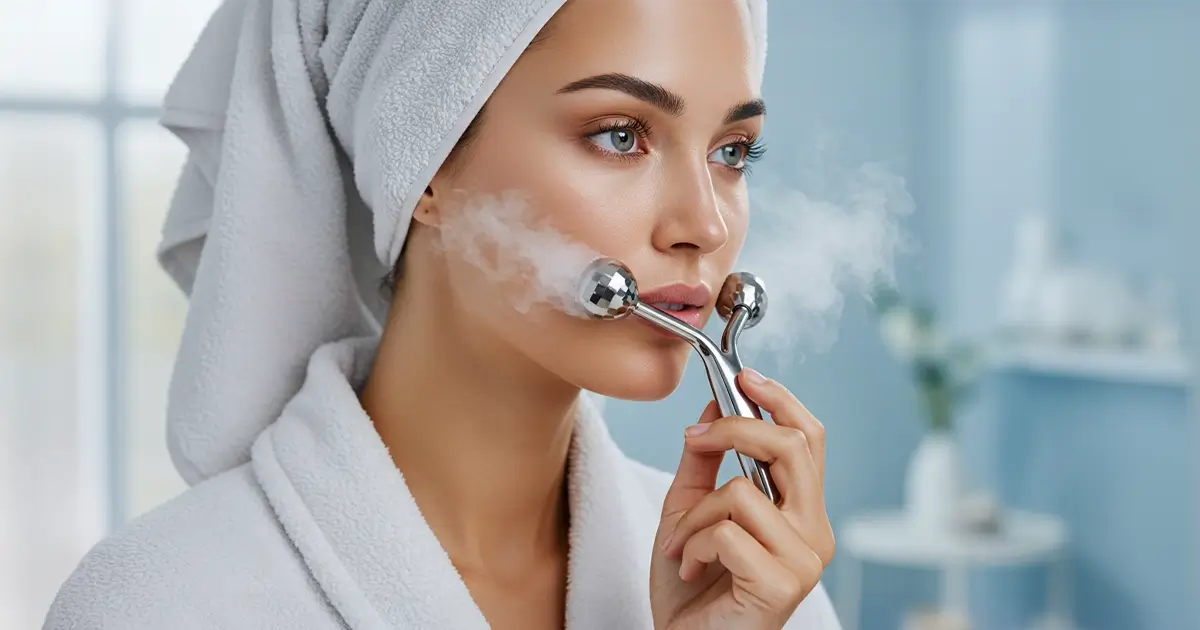Curious about the sudden buzz around home cryotherapy, facial ice globes, and other cold therapy tools? I'm unpacking the science, the gadgets, and the daily do-or-don't so you can chill out - literally - without freezing your face or your wallet.
Why Chill Thrills the Skin
When skin meets cold, surface vessels constrict, then rebound with a healthy rush of blood once warmth returns. This quick vascular dance can temporarily soften redness and lend a lively, just-stepped-outside glow. It feels brisk because it is brisk: nerve fibers fire less under cool temperatures, so irritation often quiets down.
Lymphatic flow loves a nudge, and gentle rolling with a chilled tool does exactly that. Think of it as moving sleepy traffic out of puffy under-eyes and jawlines so contours look sharper. Bonus perk: numbness from cold lowers the tingle of potent actives, letting newcomers tolerate stronger formulas without tears.
Inflammation Under Ice
Cytokines - those molecular messengers that shout "fire!" inside a breakout - slow their chatter in cooler conditions. A 2024 dermatology review noted up to a 35 percent drop in post-procedure swelling when brief cryotherapy was added In this study. Less swelling means less pigmentary fallout and smoother healing in the long run.
Cold also stiffens collagen fibers for a moment, leading to that tight-as-drums sensation many of us secretly love. Regular but sensible cooling may encourage long-term collagen remodeling, although research is young, so temper enthusiasm with common sense.
Picking Your Gadget: From Ice Cubes to Cryo Sticks
If you're a minimalist, a clean stainless-steel spoon parked in the freezer earns rookie points. Level up and you meet ice globes: glass or stainless spheres on handles that glide over cheeks like tiny planets. Higher tech brings battery-powered wands that hold sub-zero temps for ten straight minutes - brilliant for multi-taskers who hate refreezing between passes.
Weight matters. Heavier tools press lymph fluid toward drainage points better, while lighter rollers feel soothing but may need extra strokes. Handle ergonomics also count; cramped wrists ruin spa vibes. In other words, try before you commit, or buy from retailers with forgiving return policies.
Inspiration From the North?
Scandinavian saunas finish with a plunge into icy fjords, a rhythm mirrored in modern skincare routines. I dove into those traditions for my piece on Nordic cold-weather rituals, and the takeaway is clear: contrast therapy wakes up circulation and seals in hydration when followed by rich emollients.
Budget still tight? Wrap frozen peas in thin cotton and roll over skin. It's clunky yet effective and leaves dinner halfway prepped - talk about multitasking.
Safe and Sane: Temperature, Timing, Hygiene
Derms generally peg the sweet spot for facial cryo between –8 °C and 5 °C. Anything colder risks frostbite in minutes, anything warmer feels meh. Record the tool temperature with an infrared thermometer until you know your freezer's quirks. Aim for two passes of one minute each on cheeks, jaw, and forehead, then pause for skin to re-warm.
Keep a thin layer of aloe or serum as a slip agent. Dry cold on bare skin can tug at micro-cracks and leave flakes behind. Once finished, pat dry, moisturize, then high-five yourself for mastering junior-level cryotherapy.
Red Flags: When to Skip the Chill
- Active rosacea flare-ups or broken capillaries
- Open wounds, new laser spots, or fresh microneedling channels
- Sensitivity disorders like Raynaud's or cold urticaria
- Kids under twelve (their skin is thinner, so risks rise)
- Alcohol-fueled nights - poor judgment plus numb skin equals accidental frost nip
If any of these apply, set the ice down and phone a dermatologist instead. Skin is for life, not a weekend experiment.
Daily Playbook: Morning Depuff to Night Recovery
Mornings belong to under-eye globes straight out of the fridge. Glide from inner corners to temples, holding three seconds at the tail to coax fluid downwards. Follow with caffeine serum while skin is still cool; absorption bumps up as vasculature rebounds.
Mid-afternoon slump? Roll a chilled jade cylinder along the hairline to tame stress-induced tension and cut shine. It doubles as a mini-migraine break - just don't let your coworkers steal it.
Pairing With Other Steps
Use acids at night, then apply cold therapy ten minutes later to hush potential stinging. Retinoid veterans swear redness eases faster this way. For barrier repair nights, pair cold with a thick ceramide balm so moisture locks in once vessels dilate back to normal.
After workouts, ice rollers calm flushed cheeks and create a mental finish line. Somehow lifting dumbbells feels nobler when the cooldown happens on your sofa.
Tool TLC: Cleaning, Storage, and Replacement
Gadgets that live in freezers pick up popsicle drips and last-week steak marinade - gross. Rinse tools with fragrance-free soap, dry fully, then store in a zip bag. Bacteria hate cold but adore moisture, so wipe off condensation before parking them back on ice.
Inspect glass globes monthly for hairline cracks. Freezer expansion can turn tiny flaws into explosive shards mid-roll, a surprise nobody asked for. Replace silicone-sheathed heads yearly; material breaks down invisibly yet snags delicate skin when you least expect it.
Quick Troubleshooting
Fogging up faster than your morning mirror? Leave the tool out sixty seconds before touching skin; radical temp swings cause condensation puddles. Handle frostbite - yes, tools can get frostbite - by wrapping the grip in a thin microfiber sleeve so fingers stay toasty.
If temperatures feel wildly uneven, test different freezer shelves. The rear corners often plunge several degrees colder than the door, and you can use that variation for rapid chill or gentle glide days without buying extras. Pretty handy, right?
FAQ
Can I use ice directly on skin instead of a tool?
You can, but cubes melt fast, create uneven pressure, and may stick to damp skin. A smooth stainless roller delivers a steadier temperature and spares you dripping elbows.
How long should a single session last?
Keep total contact time under five minutes for the whole face. Longer exposure offers no extra benefit and raises frostbite odds.
Is daily cryotherapy too much?
Most people handle light cooling once a day without trouble. If skin starts feeling tight or flaky, scale back to three times a week.
Will cold therapy shrink pores permanently?
Cold makes pores look smaller by tightening surrounding tissue, but the effect is temporary. Consistent cleansing and sun protection influence real pore health far more.
Can I combine cryotherapy with LED masks?
Yes - use LED first on a dry face, then cool down afterward. The sequence calms any warmth from the light while locking in post-treatment serums.
Conclusion
Home cryotherapy tools win hearts because they're quick, satisfying, and, when used wisely, science-backed. Respect temperature limits, keep gadgets squeaky clean, and listen to your skin's feedback - no device should hurt or leave lingering ice marks.
I'd love to know your frostiest success stories or biggest chilly fails, so drop a comment below. See you in the next post - until then, take good care of your skin!


Comments (0)
No comments yet - be the first to share your thoughts!
Leave a Reply
Your email address will not be published. Required fields are marked *